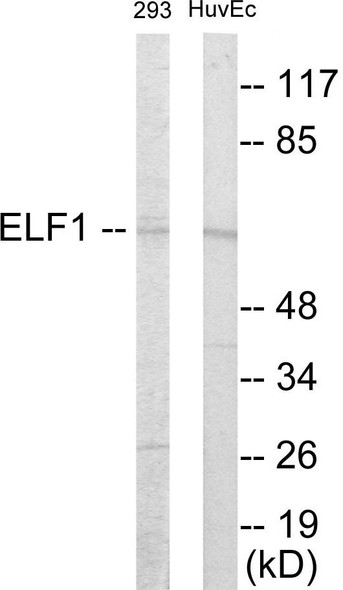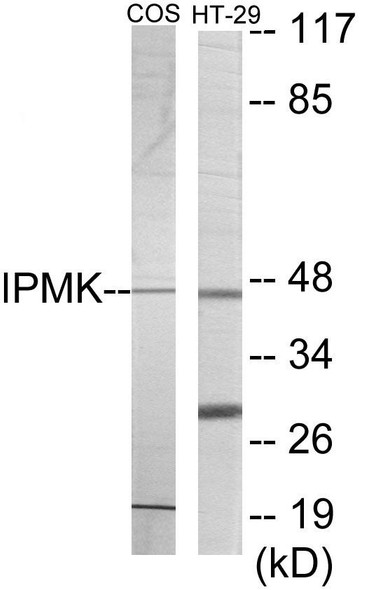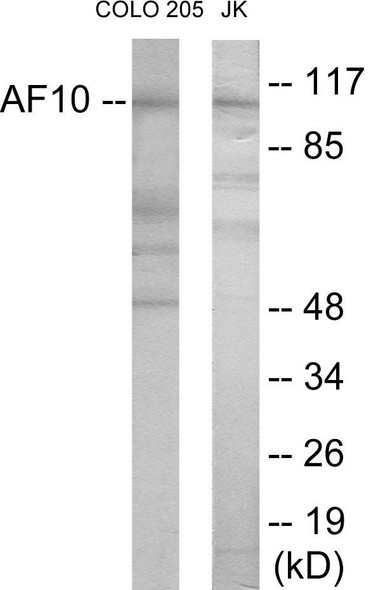Epigenetics and Nuclear Signaling
TRIM24 Colorimetric Cell-Based ELISA
- SKU:
- CBCAB00375
- Product Type:
- ELISA Kit
- ELISA Type:
- Cell Based
- Research Area:
- Epigenetics and Nuclear Signaling
- Reactivity:
- Human
- Reactivity:
- Mouse
- Detection Method:
- Colorimetric
Description
| Product Name: | TRIM24 Colorimetric Cell-Based ELISA |
| Product Code: | CBCAB00375 |
| ELISA Type: | Cell-Based |
| Target: | TRIM24 |
| Reactivity: | Human, Mouse |
| Dynamic Range: | > 5000 Cells |
| Detection Method: | Colorimetric 450 nmStorage/Stability:4°C/6 Months |
| Format: | 96-Well Microplate |
The TRIM24 Colorimetric Cell-Based ELISA Kit is a convenient, lysate-free, high throughput and sensitive assay kit that can detect TRIM24 protein expression profile in cells. The kit can be used for measuring the relative amounts of TRIM24 in cultured cells as well as screening for the effects that various treatments, inhibitors (ie siRNA or chemicals), or activators have on TRIM24.
Qualitative determination of TRIM24 concentration is achieved by an indirect ELISA format. In essence, TRIM24 is captured by TRIM24-specific primary antibodies while the HRP-conjugated secondary antibodies bind the Fc region of the primary antibody. Through this binding, the HRP enzyme conjugated to the secondary antibody can catalyze a colorimetric reaction upon substrate addition. Due to the qualitative nature of the Cell-Based ELISA, multiple normalization methods are needed:
| 1. | A monoclonal antibody specific for human GAPDH is included to serve as an internal positive control in normalizing the target absorbance values. |
| 2. | Following the colorimetric measurement of HRP activity via substrate addition, the Crystal Violet whole-cell staining method may be used to determine cell density. After staining, the results can be analysed by normalizing the absorbance values to cell amounts, by which the plating difference can be adjusted. |
| Database Information: | Gene ID: 8805, UniProt ID: O15164, OMIM: 188550/603406, Unigene: Hs.490287 |
| Gene Symbol: | TRIM24 |
| Sub Type: | None |
| UniProt Protein Function: | TRIM24: an atypical protein kinase that functions as a transcriptional coactivator. Originally identified as a mammalian protein that enhances the AF-2 activity of the retinoid X receptor (RXR) in a yeast genetic screen. Binds to nuclear receptors in an agonist and AF2-activating domain (AF2-AD) dependent manner. Binding to the agonist-nuclear receptor complex induces its own hyperphosphorylation as well as the phosphorylation of TFIIEa, TAFII28, and TAFII55. Belongs to a family of nuclear proteins that includes TIF1b and TIF1g. TIF1 proteins are characterized by an N-terminal region that contains a RING finger-B boxes-coiled coil (RBCC) motif, a poorly conserved central region, a C-terminal region that contains a PHD finger, and a bromodomain. Interacts with the heterochromatin-associated proteins HP1a, MOD1 (HP1b), and MOD2 (HP1g) and with the transcriptional repression domain KRAB, which is present in many Kruppel-type (C2H2) zinc finger proteins. May act as a repressor through the formation of transcriptionally inactive heterochromatin. Two splice variant isoforms have been described. |
| UniProt Protein Details: | Protein type:ATYPICAL group; EC 6.3.2.-; Kinase, protein; Nuclear receptor co-regulator; Protein kinase, atypical; TIF1 family; Transcription, coactivator/corepressor; Tumor suppressor; Ubiquitin conjugating system Chromosomal Location of Human Ortholog: 7q33-q34 Cellular Component: cytosol; nucleoplasm; nucleus Molecular Function:chromatin binding; estrogen response element binding; methylated histone residue binding; p53 binding; protein binding; protein-tyrosine kinase activity; receptor binding; transcription coactivator activity; ubiquitin-protein ligase activity; zinc ion binding Biological Process: protein catabolic process; protein ubiquitination; regulation of apoptosis; regulation of protein stability; transcription from RNA polymerase II promoter Disease: Thyroid Carcinoma, Papillary |
| NCBI Summary: | The protein encoded by this gene mediates transcriptional control by interaction with the activation function 2 (AF2) region of several nuclear receptors, including the estrogen, retinoic acid, and vitamin D3 receptors. The protein localizes to nuclear bodies and is thought to associate with chromatin and heterochromatin-associated factors. The protein is a member of the tripartite motif (TRIM) family. The TRIM motif includes three zinc-binding domains - a RING, a B-box type 1 and a B-box type 2 - and a coiled-coil region. Two alternatively spliced transcript variants encoding different isoforms have been described for this gene. [provided by RefSeq, Jul 2008] |
| UniProt Code: | O15164 |
| NCBI GenInfo Identifier: | 12746552 |
| NCBI Gene ID: | 8805 |
| NCBI Accession: | O15164.3 |
| UniProt Secondary Accession: | O15164,O95854, A4D1R7, A4D1R8, |
| UniProt Related Accession: | O15164 |
| Molecular Weight: | 117kDa |
| NCBI Full Name: | Transcription intermediary factor 1-alpha |
| NCBI Synonym Full Names: | tripartite motif containing 24 |
| NCBI Official Symbol: | TRIM24 |
| NCBI Official Synonym Symbols: | PTC6; TF1A; TIF1; RNF82; TIF1A; hTIF1; TIF1ALPHA |
| NCBI Protein Information: | transcription intermediary factor 1-alpha |
| UniProt Protein Name: | Transcription intermediary factor 1-alpha |
| UniProt Synonym Protein Names: | E3 ubiquitin-protein ligase TRIM24; RING finger protein 82; RING-type E3 ubiquitin transferase TIF1-alphaCurated; Tripartite motif-containing protein 24 |
| Protein Family: | Transcription intermediary factor |
| UniProt Gene Name: | TRIM24 |
| Component | Quantity |
| 96-Well Cell Culture Clear-Bottom Microplate | 2 plates |
| 10X TBS | 24 mL |
| Quenching Buffer | 24 mL |
| Blocking Buffer | 50 mL |
| 15X Wash Buffer | 50 mL |
| Primary Antibody Diluent | 12 mL |
| 100x Anti-Phospho Target Antibody | 60 µL |
| 100x Anti-Target Antibody | 60 µL |
| Anti-GAPDH Antibody | 60 µL |
| HRP-Conjugated Anti-Rabbit IgG Antibody | 12 mL |
| HRP-Conjugated Anti-Mouse IgG Antibody | 12 mL |
| SDS Solution | 12 mL |
| Stop Solution | 24 mL |
| Ready-to-Use Substrate | 12 mL |
| Crystal Violet Solution | 12 mL |
| Adhesive Plate Seals | 2 seals |
The following materials and/or equipment are NOT provided in this kit but are necessary to successfully conduct the experiment:
- Microplate reader able to measure absorbance at 450 nm and/or 595 nm for Crystal Violet Cell Staining (Optional)
- Micropipettes with capability of measuring volumes ranging from 1 µL to 1 ml
- 37% formaldehyde (Sigma Cat# F-8775) or formaldehyde from other sources
- Squirt bottle, manifold dispenser, multichannel pipette reservoir or automated microplate washer
- Graph paper or computer software capable of generating or displaying logarithmic functions
- Absorbent papers or vacuum aspirator
- Test tubes or microfuge tubes capable of storing ≥1 ml
- Poly-L-Lysine (Sigma Cat# P4832 for suspension cells)
- Orbital shaker (optional)
- Deionized or sterile water
*Note: Protocols are specific to each batch/lot. For the correct instructions please follow the protocol included in your kit.
| Step | Procedure |
| 1. | Seed 200 µL of 20,000 adherent cells in culture medium in each well of a 96-well plate. The plates included in the kit are sterile and treated for cell culture. For suspension cells and loosely attached cells, coat the plates with 100 µL of 10 µg/ml Poly-L-Lysine (not included) to each well of a 96-well plate for 30 minutes at 37°C prior to adding cells. |
| 2. | Incubate the cells for overnight at 37°C, 5% CO2. |
| 3. | Treat the cells as desired. |
| 4. | Remove the cell culture medium and rinse with 200 µL of 1x TBS, twice. |
| 5. | Fix the cells by incubating with 100 µL of Fixing Solution for 20 minutes at room temperature. The 4% formaldehyde is used for adherent cells and 8% formaldehyde is used for suspension cells and loosely attached cells. |
| 6. | Remove the Fixing Solution and wash the plate 3 times with 200 µL 1x Wash Buffer for five minutes each time with gentle shaking on the orbital shaker. The plate can be stored at 4°C for a week. |
| 7. | Add 100 µL of Quenching Buffer and incubate for 20 minutes at room temperature. |
| 8. | Wash the plate 3 times with 1x Wash Buffer for 5 minutes each time. |
| 9. | Add 200 µL of Blocking Buffer and incubate for 1 hour at room temperature. |
| 10. | Wash 3 times with 200 µL of 1x Wash Buffer for 5 minutes each time. |
| 11. | Add 50 µL of 1x primary antibodies (Anti-TRIM24 Antibody and/or Anti-GAPDH Antibody) to the corresponding wells, cover with Parafilm and incubate for 16 hours (overnight) at 4°C. If the target expression is known to be high, incubate for 2 hours at room temperature. |
| 12. | Wash 3 times with 200 µL of 1x Wash Buffer for 5 minutes each time. |
| 13. | Add 50 µL of 1x secondary antibodies (HRP-Conjugated AntiRabbit IgG Antibody or HRP-Conjugated Anti-Mouse IgG Antibody) to corresponding wells and incubate for 1.5 hours at room temperature. |
| 14. | Wash 3 times with 200 µL of 1x Wash Buffer for 5 minutes each time. |
| 15. | Add 50 µL of Ready-to-Use Substrate to each well and incubate for 30 minutes at room temperature in the dark. |
| 16. | Add 50 µL of Stop Solution to each well and read OD at 450 nm immediately using the microplate reader. |
(Additional Crystal Violet staining may be performed if desired – details of this may be found in the kit technical manual.)






